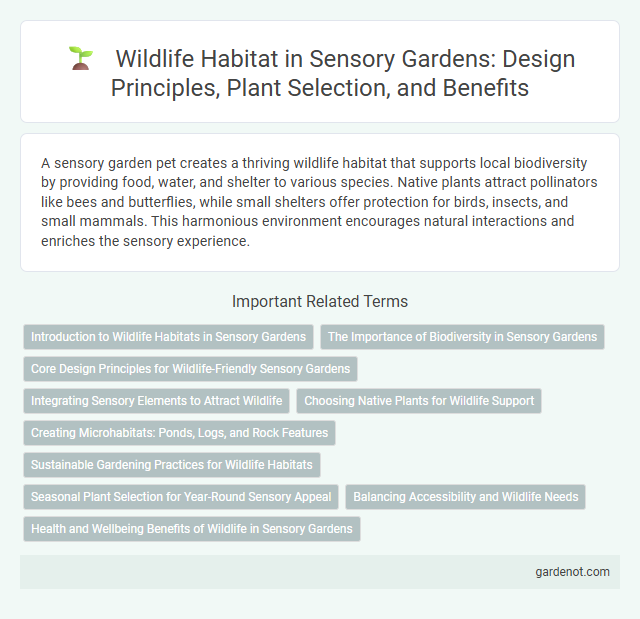A sensory garden pet creates a thriving wildlife habitat that supports local biodiversity by providing food, water, and shelter to various species. Native plants attract pollinators like bees and butterflies, while small shelters offer protection for birds, insects, and small mammals. This harmonious environment encourages natural interactions and enriches the sensory experience.
Introduction to Wildlife Habitats in Sensory Gardens
Wildlife habitats in sensory gardens create immersive environments that support diverse fauna, enhancing ecological balance while engaging visitors' senses. These habitats incorporate native plants, water features, and shelter that attract birds, butterflies, and beneficial insects, fostering biodiversity. Such gardens promote environmental education and conservation awareness by connecting individuals with nature through sight, sound, touch, smell, and taste.
The Importance of Biodiversity in Sensory Gardens
Biodiversity in sensory gardens enhances wildlife habitats by providing diverse plant species that support pollinators, birds, and beneficial insects, creating a balanced ecosystem. Rich biodiversity improves sensory experiences through varied textures, scents, and colors that stimulate the senses and promote environmental education. Maintaining a wide range of native flora ensures the sustainability and resilience of sensory gardens against environmental changes.
Core Design Principles for Wildlife-Friendly Sensory Gardens
Wildlife-friendly sensory gardens prioritize native plant species that provide food, shelter, and breeding sites to attract local fauna such as pollinators, birds, and small mammals. Design principles emphasize layered vegetation with a mix of ground covers, shrubs, and trees to create diverse habitats supporting biodiversity and natural ecological processes. Incorporating water sources, avoiding chemical pesticides, and ensuring connectivity with surrounding green spaces enhance the garden's function as a thriving wildlife habitat.
Integrating Sensory Elements to Attract Wildlife
Integrating sensory elements such as native plants with distinct scents, textured foliage, and vibrant colors creates a wildlife-attracting habitat in sensory gardens. Water features provide auditory stimulation while supporting amphibians and birds, enhancing biodiversity. Incorporating diverse sensory stimuli encourages pollinators like bees and butterflies, fostering a balanced ecosystem within the garden space.
Choosing Native Plants for Wildlife Support
Choosing native plants for a sensory garden enhances wildlife habitat by providing essential food, shelter, and nesting sites for local birds, insects, and mammals. Native species support pollinators like bees and butterflies by offering familiar nectar and pollen sources, which contribute to biodiversity. Incorporating diverse native flora ensures a balanced ecosystem, promoting ecological resilience and sustaining wildlife populations throughout the seasons.
Creating Microhabitats: Ponds, Logs, and Rock Features
Creating microhabitats such as ponds, logs, and rock features in a sensory garden enhances biodiversity by providing essential shelter, breeding grounds, and food sources for local wildlife. These elements support amphibians, insects, small mammals, and birds, contributing to a balanced ecosystem and increased pollination. Incorporating varied structures establishes thriving micro-ecological zones that promote natural wildlife behaviors and enrich visitor sensory experiences.
Sustainable Gardening Practices for Wildlife Habitats
Sustainable gardening practices for wildlife habitats prioritize native plant species to provide essential food and shelter, supporting local biodiversity and pollinators like bees and butterflies. Incorporating organic mulches and avoiding chemical pesticides create a safe environment for insects, birds, and small mammals. Water conservation techniques such as rain gardens and drip irrigation promote habitat sustainability while reducing resource consumption.
Seasonal Plant Selection for Year-Round Sensory Appeal
Selecting diverse plant species that bloom and release scents across different seasons enhances the sensory garden's appeal for wildlife habitat. Incorporating native wildflowers, shrubs, and trees ensures continuous food sources such as nectar, berries, and shelter for pollinators, birds, and small mammals throughout the year. Seasonal plant selection boosts biodiversity while maintaining visual interest and aromatic stimulation in every season.
Balancing Accessibility and Wildlife Needs
Creating a sensory garden that supports wildlife habitat requires careful planning to balance accessibility and ecological needs. Integrating native plants and natural features provides food and shelter for local species while designing pathways and interactive elements with smooth surfaces and appropriate widths ensures inclusivity for all visitors. Strategic placement of habitat zones away from high-traffic areas minimizes disturbance, promoting biodiversity alongside an engaging and accessible sensory experience.
Health and Wellbeing Benefits of Wildlife in Sensory Gardens
Wildlife habitats in sensory gardens enhance mental health by promoting stress reduction and calming sensory experiences through natural sounds and sights. Exposure to diverse flora and fauna supports emotional wellbeing by fostering a restorative environment that stimulates all senses. Interaction with wildlife within these gardens encourages physical activity and social connection, contributing to overall holistic health.
Wildlife habitat Infographic

 gardenot.com
gardenot.com